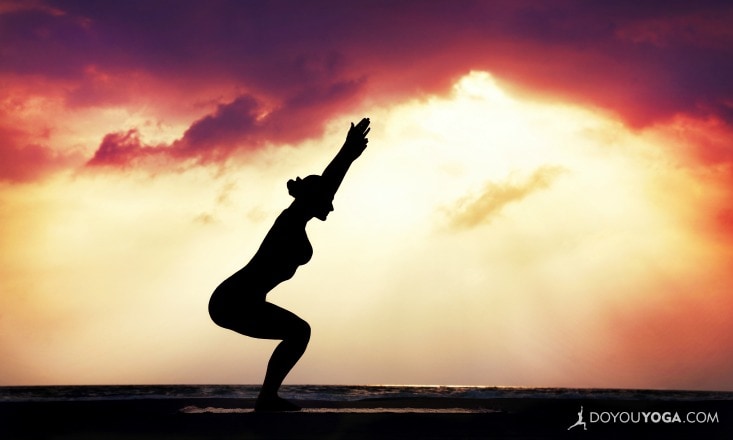The knee, the largest and most complex joint in the human body, is designed to glide smoothly along a “track” in the thighbone (femur) known as the trochlear groove.
However, because the kneecap (patella) is a floating joint held in place by connective tissue and cartilage, it is prone to getting “out of the groove.” Tight hips and weak inner thighs also contribute to making the knee especially vulnerable to injury and chronic discomfort during yoga.
An asana practice focused on strengthening the inner quadricep muscles, aligning the joints in the legs, and stretching the outer hips ensures that you don’t feel weak in the knees on or off your yoga mat.
If you’re new to the asana practice of yoga, or perhaps you’re returning to the mat after an injury, it’s good to slowly build your body up with regular, daily movement. To help build up those vital inner quadricep muscles and making sure you feel strong around the tender knee, sign up to the free 30 Day Yoga Challenge. You’ll be guided through common postures and you’ll learn how to hold yourself in poses, so you don’t harm or hurt your knees.
Below are five easy yoga pose variations on some common postures that optimize the physiological function of the knees so you can continue standing and walking tall and enjoy pain-free yoga.
1. Mountain Pose: Make It a Block Party

Mountain Pose or Tadasana sets the stage for many standing poses. However, this pose often exacerbates a “knock kneed” posture which internally rotates the femur bones and overuses the outer hips (tight IT bands, anyone?), thus weakening the inner thighs.
Strategically using a block can help you align the knees directly under the hips, broaden the hamstrings, and strengthen the weaker muscles of the quadricep group, preparing for a healthier and happier practice.
- Stand with your feet parallel, about hip width distance.
- Squeeze a block above your knees, between your mid to upper thighs to strengthen the Vastus Medialis ( the innermost quadricep muscle).
- Maintain a lengthened spine without excessively rounding the lumbar spine.
- You can also try this technique in Utkatasana and/or Uttanasana to receive the same benefits.
2. Chair Pose: Get in the Hot Seat

Chair Pose or Utkatasana often places unnecessary strain on the knees by hyperextending the joint.
However, a tight and/or weak lower back and underused glutes and hamstrings limit the stability needed to keep the knees at that 90-degree-angle, and you end up compensating by sending them far past the toes and into the danger zone.
If you find this angle challenging, try using a wall to help you evenly distribute your body weight amongst your quadricep, hamstring, and glute complex. Together, these muscles will act as a shock absorbing team, protecting the knees from taking on too much and buckling under the pressure.
Similar to Mountain Pose, make sure the knees do not cave in towards the midline.
- Set your Chair Pose against a wall.
- Keep your torso upright and try pressing a little more weight into the heels to better activate the muscles in the back of the leg.
- Avoid sitting too low.
- This 90-degree-angle and foot placement also shows up in Warrior I, II, and Side Angle Pose.
3. Extended Triangle Pose: UN-Lock and Load
 Image Credit: Julia Lee
Image Credit: Julia LeeExtended Triangle or Utthita Trikonasana unlocks the knee and loads the muscle! While some students experience tension from a lack of flexibility in the low back and hamstring area during this pose, many students are TOO flexible in the knee—this hypermobility can stress the joint and create damage.
You can strike a balance by microbending the front knee to alleviate pain in the lumbar spine and to ease deeper into the hamstring.
4. Supported Reclining Hero Pose: Get Back on Track

Supta Virasana to the RESCUE!
This variation of Hero Pose can work miracles on knees that slip off the track due to overworked outer thighs, lots of running, or habitually crossing your legs at your desk. And, the divine quadricep and hip flexor stretch here can’t be beat!
Keeping your shins and butt on the floor takes time and a certain flexibility that is not attainable for all. The use of props makes this possible and enjoyable! Here’s the safest set up:
- Create a t-shaped “ramp” with two bolsters, one for your spine and one to support your head.
- From Hero Pose, place some folded blankets beneath the hips and make sure the toes face straight back, not off to the sides.
- Recline back into this blissfully restorative and healing posture!
5. Half Lotus: Hips Don’t Lie

The knee will feel a pinching if pushed beyond the limit of safety. This must not be ignored. To proceed with caution, consider these tips.
- Begin in Firelog Pose with both shins parallel to the top edge of the mat.
- Support an upright spine by keeping the hands behind you on the floor.
- Flex the foot of the top leg as to not sickle the ankle, which may lead to misalignment of the knee.
- Gradually, lean forward and/or move the foot closer to the hip crease as you gain comfort in this pose.
- Repeat with the second leg.
While yoga offers powerful and effective movements to strengthen and stabilize the knees, there is no substitute for mindfulness and patience. Pay attention to what works and what does not work, and if you have any doubts, ask your yoga teacher to advise you.
Your knees will never hesitate to let you know if you have gone too far, and the painful consequence is not worth getting into a pose that might not suit you. I hope this article reminds you that you have many options and that you need not suffer through your practice.


